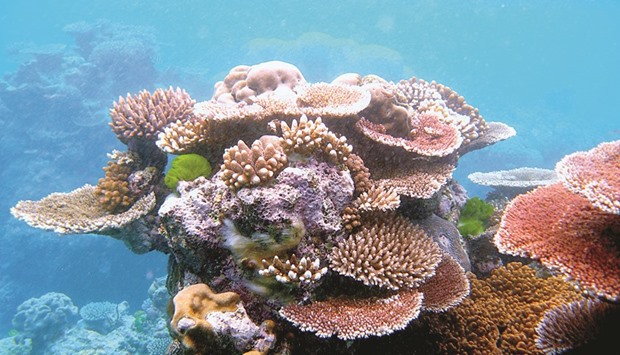Australia’s Great Barrier Reef is being damaged. It’s not tourists, marine life, or even illegal fishermen who are causing the destruction, but the temperature of the water. It’s simply too hot for the delicate ecosystem.
The Great Barrier Reef is a mosaic of nearly 3,000 individual reefs that lie off the coast of Queensland, northeast Australia. It stretches an incredible 2,000 kilometres (1,200 miles), which is nearly the distance from Doha to Cyprus. It’s so large, that it is even visible from space.
Coral reefs are some of the most diverse ecosystems on Earth, they support more species per unit area than any other marine environment. The Great Barrier Reef is made up of 400 different types of coral, and is home to 1,500 types of fish, thousands of molluscs and many other sea creatures such as the large green turtle.
Despite their size and diversity, coral reefs are incredibly fragile. They are particularly vulnerable to changes in sea temperature, which occurs naturally during an El Nino event. El Nino is the name given to the slight warming of the surface waters of the Pacific Ocean, and the current El Nino event is one of the strongest on record.
The extent of the damage is alarming. Aerial surveys performed by the National Coral Bleaching Taskforce revealed that the majority of the 500 reefs that they observed were undergoing extensive damage known as bleaching.
A healthy coral reef is usually brightly coloured and teaming with marine life. In order to thrive, it needs a good supply of sunshine and clean, warm water. Even a small change in the conditions can have a major impact on the coral.
The vivid colours of the reef are due to an algae species that lives within the coral. As well as colour, these tiny single-celled organisms also provide the coral with food. They photosynthesise in the same way that plants do, processing the carbon dioxide and nitrous waste produced by the corals and in exchange supplying the corals with oxygen and sugars.
If the temperature changes or if the sunlight is reduced, then the coral ejects the tiny algae in order to preserve itself. This removes the colour and the food supply from the coral, leaving it a white colour and vulnerable to disease. Sometimes this bleaching can be temporary, but in many cases the coral never recovers. A warming of just 1C for more than a week is enough to cause the coral to bleach.
Alarmingly the Australian reef is not alone. In October 2015, the National Oceanic and Atmospheric Administration in the US declared that a global coral bleaching event had started. Bleaching was first noticed in the northern Pacific Ocean in the summer of 2014, and by 2015 it had spread into the south Pacific, Indian Ocean and the Atlantic. Coral around the world was being damaged by water that was simply too warm.
This isn’t the first time that a coral bleaching event has become global. This is the third and they have all been triggered by El Nino events. The first one occurred in 1998, during the record-breaking El Nino which was the strongest on record. It is estimated that approximately 16 percent of the coral reefs around the globe were killed during the ensuing underwater heatwave.
The second bleaching episode followed 12 years later, in 2010, again set off by El Nino. This bleaching was felt worst in Southeast Asia. In Indonesia’s Aceh province, 80 percent of the coral reefs died, and in neighbouring Malaysia, officials closed a number of dive sites to try to relieve stress on the reefs and allow them to
regenerate.
Just four years later, another global bleaching event started, which is still ongoing. This current event has had a far longer duration than the previous two, and there are fears that it could extend well into 2017. The bleaching hasn’t been continuous, in different parts of the world it has waxed and waned with the changing currents, but its effects have been devastating for the coral. Some parts of the world, such as Hawaii and Fiji, have already endured two bleaching episodes in the space of a few years.
The bleaching events are becoming closer together, because the oceans are all becoming warmer. The coral hasn’t been able to adapt to the higher base temperature, so when there is a slight spike in heat from El Nino, it has a more dramatic effect on the reefs than the same rise in temperature would have had a few decades ago.
If the corals cannot recover from the bleaching, then they can disappear, being taken over by algae and seaweed. This will cause them to quickly degrade and the coral will start to erode. Not only is this the loss of a beautiful ecosystem, but it also reduces the protection of the shoreline to storms and can spell disaster to a thriving tourism industry.
As the bleaching continues, there is little to be done other than to wait to see how devastating it will be to the corals. At least this current El Nino event is coming to an end and over the coming months the heat should slowly begin to subside.

A variety of corals form an outcrop on Flynn Reef, part of the Great Barrier Reef near Cairns, Queensland, Australia. Photo by Toby Hudson/Wikipedia
